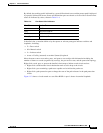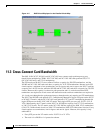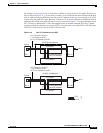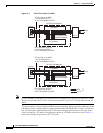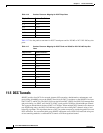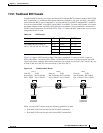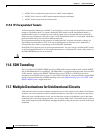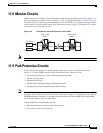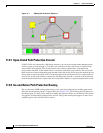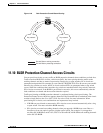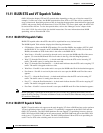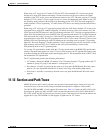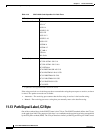
11-18
Cisco ONS 15454 Reference Manual, R7.0
78-17191-01
Chapter 11 Circuits and Tunnels
11.6 11.5.2 IP-Encapsulated Tunnels
• A SDCC that is terminated cannot be used as a DCC tunnel endpoint.
• A SDCC that is used as an DCC tunnel endpoint cannot be terminated.
• All DCC tunnel connections are bidirectional.
11.5.2 IP-Encapsulated Tunnels
An IP-encapsulated tunnel puts an SDCC in an IP packet at a source node and dynamically routes the
packet to a destination node. To compare traditional DCC tunnels with IP-encapsulated tunnels, a
traditional DCC tunnel is configured as one dedicated path across a network and does not provide a
failure recovery mechanism if the path is down. An IP-encapsulated tunnel is a virtual path, which adds
protection when traffic travels between different networks.
IP-encapsulated tunneling has the potential of flooding the DCC network with traffic resulting in a
degradation of performance for CTC. The data originating from an IP tunnel can be throttled to a
user-specified rate, which is a percentage of the total SDCC bandwidth.
Each ONS 15454 supports up to ten IP-encapsulated tunnels. You can convert a traditional DCC tunnel
to an IP-encapsulated tunnel or an IP-encapsulated tunnel to a traditional DCC tunnel. Only tunnels in
the DISCOVERED status can be converted.
Caution Converting from one tunnel type to the other is service-affecting.
11.6 SDH Tunneling
The Cisco ONS 15454 SONET MSPP provides a SDH traffic transport solution with scalable SONET,
data or DWDM multiservice capabilities. The SDH traffic is aggregated and transported across an ONS
15454 network, similar to the SONET TDM and data services. STM-1 to STM-64 payloads are
transported over SONET from any port on a Cisco ONS 15454 OC-N card provisioned to support SDH
signals. For more information on SDH tunneling, refer to the SDH Tunneling Over Cisco ONS 15454
SONET MSPP Systems Application Note.
11.7 Multiple Destinations for Unidirectional Circuits
Unidirectional circuits can have multiple destinations for use in broadcast circuit schemes. In broadcast
scenarios, one source transmits traffic to multiple destinations, but traffic is not returned to the source.
When you create a unidirectional circuit, the card that does not have its backplane receive (Rx) input
terminated with a valid input signal generates a loss of signal (LOS) alarm. To mask the alarm, create an
alarm profile suppressing the LOS alarm and apply the profile to the port that does not have its Rx input
terminated.




